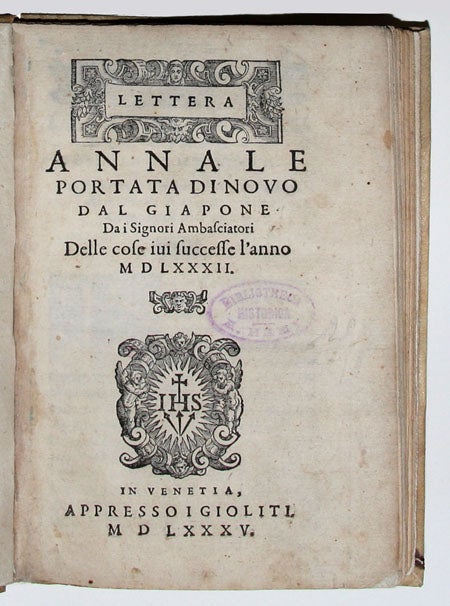
Lettera annale portata di Novo di Giapone Da I Signori Ambasciatori delle cose iui successe l’anno MDLXXXII.
8vo. 103 pp. Bound in old vellum. Discrete former ownership stamp on title. Gutter margin of title reinforced; inconsequential toning, otherwise excellent.
Rare early edition of this Jesuit letter containing news of missions and activity in Japan from the year 1582, the only edition (of 5 printed that year) to contain a title-page advertising the famous Japanese embassy of 1584-86. Significantly, the work also discusses the embassy, naming the participants and their noble lineage and expressing the hope that the embassy will prove a convincing sign of the Jesuit’s spectacular success in Japan (p. 7). The present imprint of this edition comprises the first entry in Boscaro’s bibliography of printed works related to the embassy. It thus stands at the head of nearly 50 works printed in 1585 (alone) to record and commemmorate an event that—in addition to providing a public relations coup for the Jesuits—became a watershed moment in cross-cultural exchange between the Orient and the West: “no Japanese emissaries to Europe, either before or since, aroused comparable interest or enthusiasm” (Lach).
In the annals of international relations between Europe and Japan in the 16th C, it is particularly noteworthy “how the physical presence of the Japanese [in Europe] stimulated an unexpected number of typographical presentations” (Boscaro), of which this particular Gioliti edition with the titlepage advertising the embassy—Portata de Novo Dal Giapone Dai Signori Ambasciatori—is the very first. Boscaro notes that there were four other editions of Coehho’s letter published in Italy in 1585 around the time the embassy arrived in Venice on June 25 (including another by Gioliti), but none of these uses the embassy as a way to market itself.
The report itself is also a significant document of the embassy’s genesis: Coelho composed it in February 1582, the month that the embassy of four Japanese Christian converts departed from Nagasaki. In it, he describes the ongoing missionary activity across the country: e.g. in Hirado, Amasuka, Bungo, and especially Funai (Oita City), the home of a thriving Jesuit college. Presumably, the contents of this letter as the title suggests were “brought from Japan by the eminent ambassadors” as the latest news on the Jesuits current success in that faraway land.
Though the embassy did not reach Lisbon until August 1584, it eventually was, as Coelho had hoped, a resounding success: from 1584-86 the four young Japanese nobles were the object of intense curiosity wherever they traveled, and they were treated to lavish receptions in Lisbon, Madrid, Florence, Rome, Venice, and other cities throughout Catholic Europe.
OCLC: Cornell, NYPL, HU and Newberry.
* Boscaro 1; Alt-Japan 812; Sommervogel II.1267; Cordier 78; Laures 169; Pagès 22; Lach I.2.690.
Price: $22,500.00
